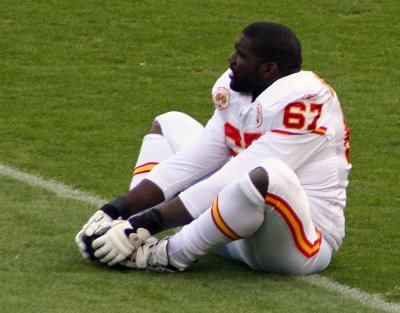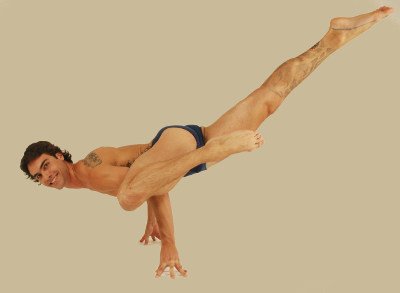What makes a Yoga posture a Yoga posture?

What are the defining characteristics that make a Yoga posture a Yoga posture?

When we see an athlete warming-up by touching their toes in what we would call a forward bend or uttanasana ~ is that Yoga?
Is this Yoga?

... or is this Yoga?

(images, with thanks, courtesy of Wikipedia Creative Commons.)
Actually, it's a bit of a trick question.
We can't tell just by looking at the form/shape, because that is not what defines Yoga posture as Yoga posture.
So how then do we identify a Yoga posture as such?
I would propose that there are two aspects/levels to address in answering this fundamental question:

Answer part 1 ~ The motivating intention/goal/destination
If we are seeking the goals of Yoga by using the principles of Yoga, then we are practising Yoga.
I discuss these goals and principles here.
So then ... if we are working to achieve Union/Wholeness through clearing/taming the mind, then a particular physical position or exercise may qualify as Yoga.
Given that our intention is such then a posture/exercise must also incorporate the principles following below in order to qualify as Yoga, in classical terms.

Answer part 2 ~ Patanjali's principles of technique
I give a brief overview of the Yoga Sutras of Patanjali here.
Patanjali gives us his definition of Yoga posture/asana in sutra Ch2.46 :
"sthirasukhamasanam"
This is an amalgamation of three Sanskrit words: Sthira, Sukha and Asana.
Sthira is variously described with such words as 'stability', 'strength', 'effort' ... etc
It is an active, 'masculine' quality.
Sukha can be described as 'softness', 'surrender', 'relaxation' ... etc
It is a passive, 'feminine' quality.
Here's some translations of this crucial sutra;
- "Yoga pose is a steady and comfortable position."
Mukunda Stiles - "Asana is steadiness and ease."
Christopher Chapple and Yogi Ananda Viraj - "The posture is firm and comfortable."
Frans Moor - "Asana must have the dual qualities of alertness and relaxation."
TKV Desikachar
So we can see that Yogaasana combines and balances the two qualities of sthira and sukha.
We can say that sthira and sukha are both means and ends within a posture.
When we work to establish these two fundamental conditions in our posture then we can call it Yoga, the practice, the journey.
And once we have successfully accomplished the balance of these two defining principles then a posture is mastered and we can call it Yoga, union, the destination (within that particular posture).
In the following two sutras Patanjali goes on to say (using my words and combining the two sutras):
That we should focus on the infinite in us (our Soul/Purusha) ... and that by doing so we will come to deeper understandings of the manifest world/universe.
In the 196 verses of the Yoga Sutras, Patanjali only mentions posture/asana four times (and once of those is just to say that it exists).
Although, with typical brevity, Patanjali says no more about asana, he gives us a great deal of scope to work with.
I will be discussing his recommendations about asana, and how we can successfully employ them in our practice, in more detail in future articles.

Landmarks, sign-posts and destinations
Can we say then, that any physical exercise, not just the usually-quoted 84 or so, can be called Yoga if we make it so by applying the criteria above.
I think we can.
Patanjali certainly does not say that we cannot.
Many of the postures, particularly the standing postures, that we employ today are not old, dating back perhaps some 100 years or so.
Mark Singleton's fascinating book 'Yoga Body' does a great job of examining the origins of modern Yoga postures.
All this is not to say that there are not many valid, 'lesser' goals/aims than Union and sthira/sukha on our Yoga posture journey.
There are, of course, many landmarks, pass-throughs and stop-overs, individual to each of us, along the way to the final destination.
For example, we may need to ease this pain, or soothe that dis-ease, or work with any number of potential physical issues in order to make progress.
Bodily issues and difficulties, chronic pain or limited mobility etc, can inhibit our access to Yoga's higher goals and they can be very effectively addressed with appropriate posture practice.
Such issues can also act as sign-posts, revealing hidden aspects of ourselves, and guiding us on our path.
A stiff, painful back, for example, can indicate a deeper emotional or perhaps karmic condition that needs to be addressed.
And that condition can often be effectively addressed, entirely or in part, via appropriate asana practice.

Conclusion
The path taken and the ultimate destination are the defining aspects of any journey and are what give that journey direction, shape and meaning.
In order to be practising Yoga we must, by classical definition, be working towards realisation of our deeper, hidden truths via the process of quietening/mastering of the mind.
That given, a Yoga posture is a Yoga posture when we employ and balance the foundational, defining characteristics of sthira and sukha.

